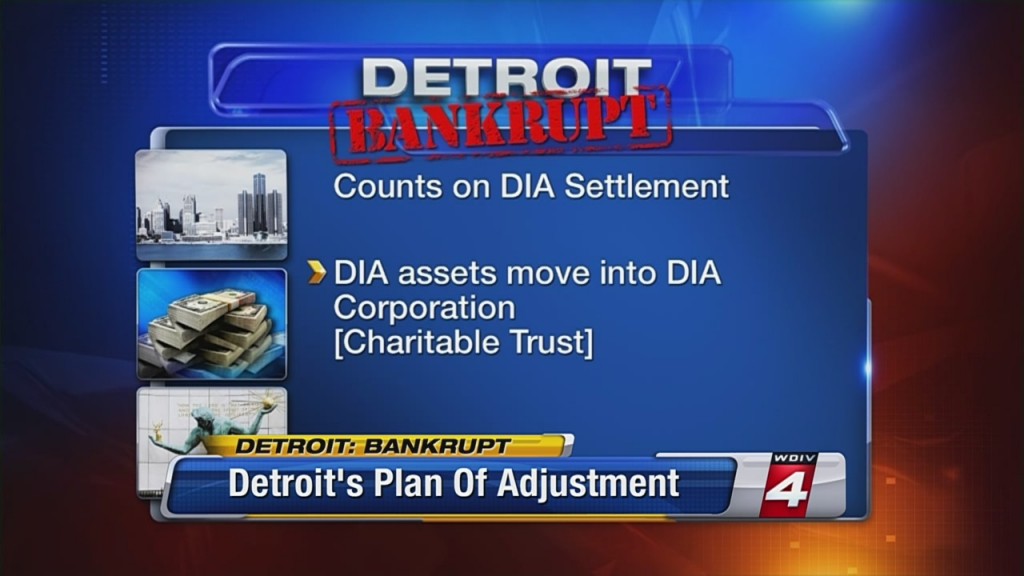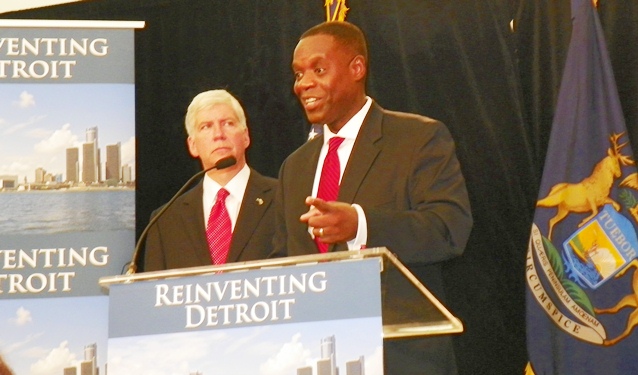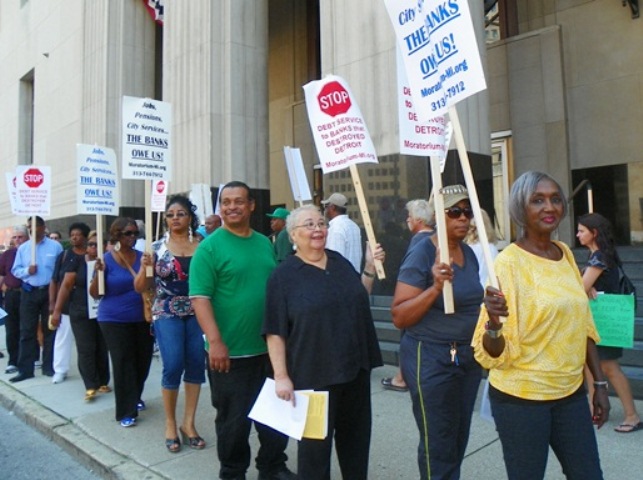
French workers have turned out in massive rallies all over the country to fight pension cuts by Hollande government.
By Workers World Detroit bureau
February 25, 2014
Emergency Manager Kevyn Orr’s “Plan of Adjustment” is a declaration of war on the city of Detroit’s 20,000 retirees and their pensions. The plan, filed Feb. 21 in the city’s bankruptcy case, calls for a 34 percent cut in monthly pension payments to non-uniformed retirees.
At a Feb. 22 meeting of the American Federation of State, County and Municipal Employees Retiree Committee, Ed McNeil, assistant to the president of AFSCME Council 25 and AFSCME representative to the “Official Committee of Retirees” created by the bankruptcy trustee, stated that the actual cut in total pension benefits amounts to 70 percent for each city retiree.
Yearly cost-of-living adjustments of 2 percent are to be eliminated. Annuity savings plans, under which pensioners were guaranteed 7.9 percent yearly interest payments on optional contributions to the pension fund, will also be drastically reduced based on alleged overpayments by the Pension Board from 1999 to 2013. The pension cuts are to be applied retroactively to the bankruptcy filing date of June 2013.
In addition to cuts in monthly cash payments, which are deferred wages earned by and belonging to city workers, retirees have already had their medical benefits drastically slashed. Life insurance and death benefits are being eliminated. Dental and vision coverage have ended.
Retired Detroit police and firefighters, who don’t get Social Security benefits, are to have their monthly pension checks cut by 10 percent, in addition to the aforesaid annuity reductions and benefit cuts.
Current city employees will have their accrued pension benefits frozen as of July 1. Their credit for pensions based on years worked will stop accumulating as of that date, with the accrued pensions subject to the same reduction as the current retirees.
Threat to public workers everywhere
 The same day EM Orr announced this full-blown attack on city of Detroit retirees, the federal Sixth Circuit Court of Appeals agreed to hear appeals filed by Detroit unions and retirees against the entire bankruptcy filing. These appeals challenge the bankruptcy for violating the Michigan constitution, which states the accrued pensions of public workers cannot be diminished or impaired.
The same day EM Orr announced this full-blown attack on city of Detroit retirees, the federal Sixth Circuit Court of Appeals agreed to hear appeals filed by Detroit unions and retirees against the entire bankruptcy filing. These appeals challenge the bankruptcy for violating the Michigan constitution, which states the accrued pensions of public workers cannot be diminished or impaired.
Orr, the bankers and the capitalists he represents want the Detroit bankruptcy to set a precedent for slashing public pensions in the 24 other states that have similar constitutional protections for public workers.
Orr had the audacity to state that the pension cuts for non-uniformed retirees will be reduced from 34 percent to 26 percent, and police and firefighters from 10 percent to 4 percent, if the unions and retiree organizations drop their legal challenges.
 Under Orr’s plan, the city, which stopped contributing to the pension plans after the bankruptcy was filed, would not make any contributions until 2023. The reduced pensions are to be funded by a $365 million donation by charitable foundations; a $100 million contribution from the Detroit Institute of Arts, which would remain open under private management pursuant to this deal; and a $350 million contribution from the state of Michigan earmarked to provide some additional benefits to the poorest retirees, also contingent on the unions dropping their opposition. If any of these sources do not make the promised payments, pensions will be slashed even further.
Under Orr’s plan, the city, which stopped contributing to the pension plans after the bankruptcy was filed, would not make any contributions until 2023. The reduced pensions are to be funded by a $365 million donation by charitable foundations; a $100 million contribution from the Detroit Institute of Arts, which would remain open under private management pursuant to this deal; and a $350 million contribution from the state of Michigan earmarked to provide some additional benefits to the poorest retirees, also contingent on the unions dropping their opposition. If any of these sources do not make the promised payments, pensions will be slashed even further.
Media misrepresentations
Much of the corporate-owned media tried to portray Orr’s plan as a concession to retirees when compared with other so-called unsecured creditors, holding $537 million in bonds, who will get only 20 cents on the dollar. But pensions are hardly “unsecured credit.” They are deferred wages, owed to city workers for labor already performed, and future payments agreed to in exchange for wage reductions by the workers on numerous occasions in order to preserve city services.

- U.S. Pres. Barack Obama plays golf with Robert Wolf, chairman/CEO of UBS AG America, which is getting fully paid on water bonds.
In contrast, in Orr’s plan the city will pay 100 percent of the principal owed on the city’s $5.35 billion Detroit Water and Sewerage Department bonds. The DWSD took out bonds totaling approximately $1 billion in 2011 and 2012, allegedly to raise funds for infrastructure repair.
The local media have not reported that half of this $1 billion in bonds was turned over to JPMorgan Chase, United Bank of Switzerland, Morgan Stanley and Loop Financial as termination fees for an interest rate swap that defaulted based on Gov. Rick Snyder’s declaration of a state of financial emergency for Detroit. (Bloomberg News, Sept.13, 2012)
Other bonds totaling approximately $585 million and backed by state revenue-sharing dollars will also be paid 100 percent. And despite the fact that Orr has challenged the legality of the city’s $1.4 billion in pension obligation certificates, he is offering those holders to settle at 40 percent of value.
Bank foreclosures not even mentioned
Orr’s 440-page statement goes into great depth about the financial crisis which led to the disastrous situation facing Detroit’s neighborhoods. However, it avoids any mention of the banks and their role in causing that crisis or any demands on them for restitution for the destruction they caused.
Orr’s report documents that after Detroit suffered a two-thirds decline in property values from 1970 to 1990 (caused by Chrysler and General Motors’ massive plant closings, also omitted from the report), property values actually increased from 1990 to the mid-2000s as Detroit’s neighborhoods and population stabilized.
In the mid-2000s, however, Detroit, an 85 percent African-American city with a high rate of homeownership, was targeted by the banks with racist, predatory, fraudulent mortgage loans and refinancings. From 2004 to 2006, 73 percent of mortgages written in Detroit were subprime. Oppressed homeowners across the U.S. faced a similar nightmare.
The city’s Planning and Development Department reported in January 2009 that Detroit had the highest home foreclosure rate among U.S. cities, with 67,000 foreclosed properties from 2005 to 2009, 65 percent of which remained vacant. There were at least another 40,000 mortgage foreclosures from 2009 to 2013, on top of tens of thousands of property tax foreclosures. This foreclosure epidemic caused the destruction of Detroit’s neighborhoods and the loss of one-quarter of the city’s population.
The centerpiece of Orr’s program for “revitalizing” Detroit is a massive blight-removal program to demolish 80,000 vacant buildings in the city. But there is not one word about making the banks pay for the devastation they have wreaked. Instead, pensioners are to take deep cuts in their monthly income.
Fightback can reverse this attack
The questions now are whether the retirees will lead the way in taking to the streets in numbers necessary to reverse this anti-working class offensive, and whether the union leadership will mobilize its members nationally to come to Detroit, which is ground zero in the war on public unions and in the austerity imposed by finance capital on the world’s working class.
Emergency Manager Orr’s plan of adjustment has to be approved by U.S. Bankruptcy Judge Steven Rhodes before it is implemented. As in any working-class struggle, it is actions in the streets, not decisions in the court, which will be decisive. It is not too late to turn things around.
For more information, visit moratorium-mi.org and detroitdebtmortorium.org.
Detroit struggle ramps up versus emergency manager
Resistance ramps up against Detroit bankruptcy as role of banks is exposed
Detroit City Council tells EM and banks, ‘No!’






